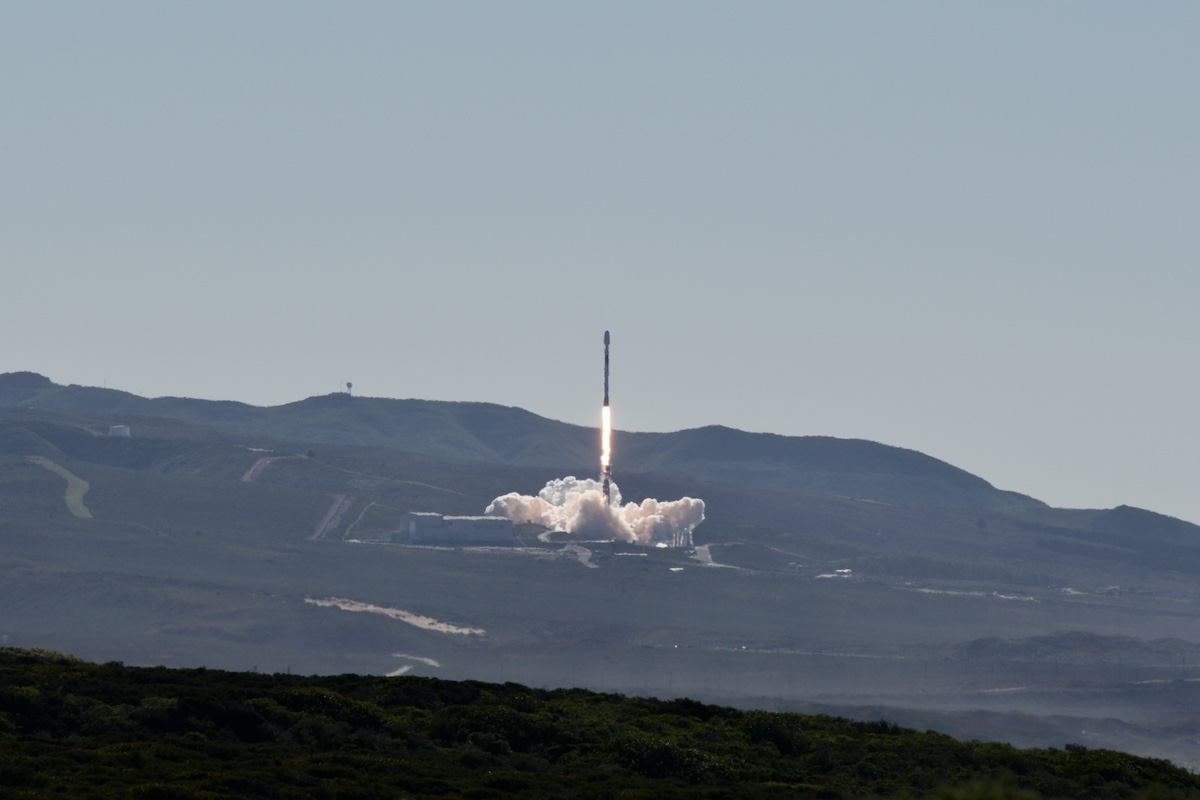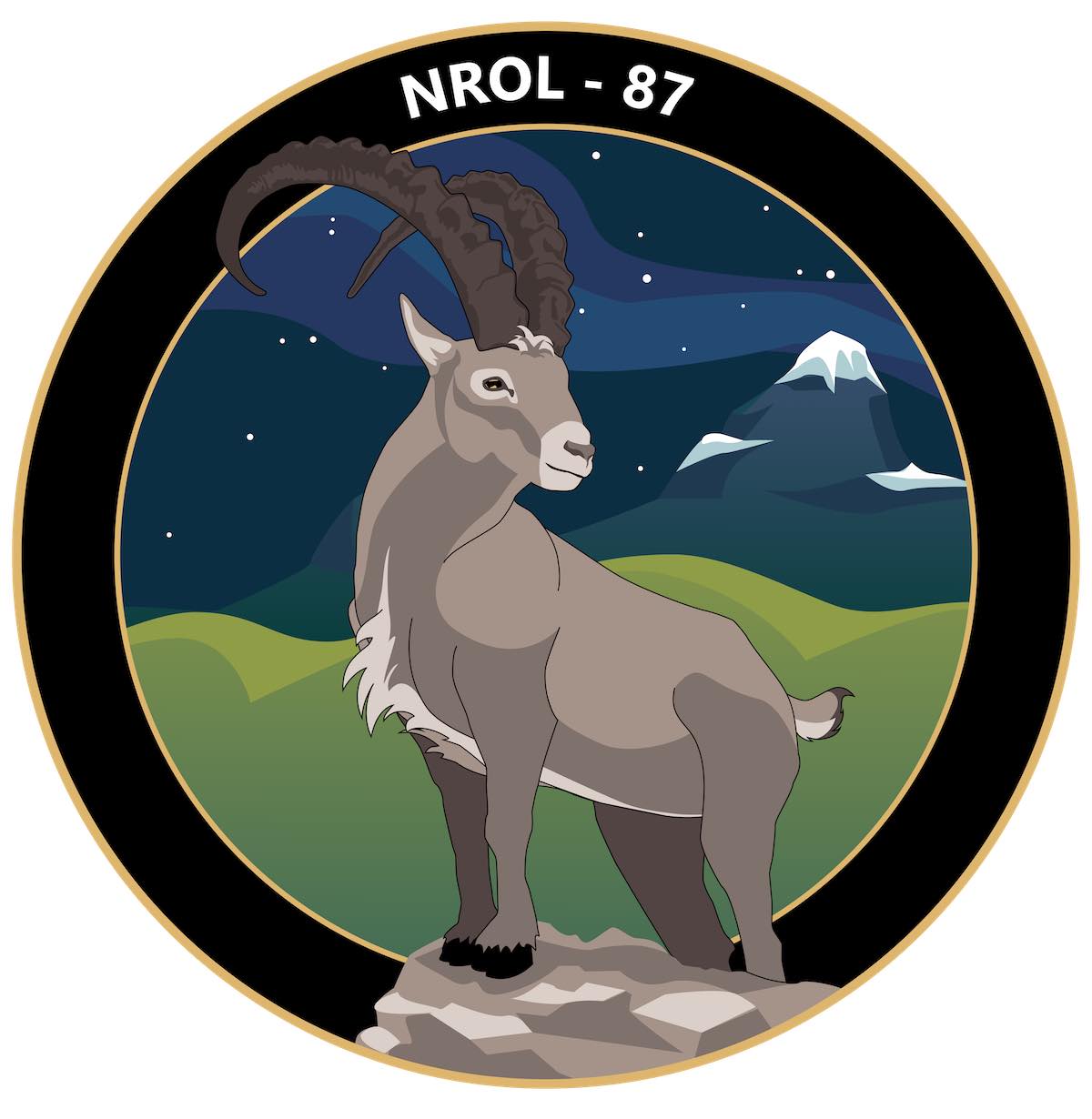
SpaceX hauled a classified payload into orbit for the U.S. government’s spy satellite agency Wednesday from Vandenberg Space Force Base in California, accomplishing another successful launch and landing on the second of three Falcon 9 rocket missions planned this week.
The launch from California followed a Falcon 9 mission from Cape Canaveral Space Force Station on Monday night with an Italian radar satellite. SpaceX has another Falcon 9 rocket on a launch pad at NASA’s Kennedy Space Center in Florida for liftoff Thursday with 49 more Starlink internet satellites.
A Falcon 9 rocket vaulted away from Space Launch Complex 4-East at Vandenberg at 12:27:26 p.m. PST (3:27:26 p.m. EST; 2027:26 GMT), powered by nine Merlin engines burning kerosene fuel and generating 1.7 million pounds of thrust.
The cargo on-board the 229-foot-tall (70-meter) rocket was a payload for the National Reconnaissance Office, which owns the government’s fleet of spy satellites mapping Earth with optical and radar imagery, monitoring the communications of foreign adversaries, and tracking global naval movements.
The Falcon 9 rocket headed south from Vandenberg, located on the Pacific coast between Los Angeles and San Francisco, and soared through the atmosphere in the first few minutes of flight.
The rocket’s first stage shut down and separated after firing for nearly two-and-a-half minutes. Three of the booster stage’s Merlin engines ignited to propel the rocket back toward Vandenberg, while the Falcon 9’s second stage engine fired to continue accelerating into orbit.
Staging confirmed. SpaceX’s Falcon 9 booster is returning to Vandenberg Space Force Base for landing.
The upper stage ignited to continue the climb into orbit with the NROL-87 payload.https://t.co/nsNiSrfKJW pic.twitter.com/4eaSuB67ho
— Spaceflight Now (@SpaceflightNow) February 2, 2022
The nearly 16-story-tall booster stage followed an arc to a peak altitude of 89 miles (144 kilometers) before plunging back to Earth, using hypersonic grid fins and engine burns to slow down for a vertical landing at Vandenberg. Four legs unfurled from the base of the rocket as it settled onto the ground at Landing Zone 4, SpaceX’s West Coast landing site a quarter-mile from the mission’s launch pad.
SpaceX’s live webcast followed the rocket’s descent and landing with on-board camera views. The company confirmed separation of the payload fairing from the upper stage nearly three minutes into the mission, revealing the classified NRO payload after reaching space.
But updates on the progress of the upper stage ended there at the request of the NRO, which cloaks its missions in secrecy, citing national security reasons.
The upper stage was expected to fire around six minutes to place the NRO payload into a preliminary orbit. A second burn was expected after rocket flew halfway around the world, setting the stage for deployment of the top secret spy spacecraft.
But all of those milestones occurred in secret. In a press release about two hours after the launch, the National Reconnaissance Office declared success on the mission, which was codenamed NROL-87.
“The Falcon 9 delivered a national security payload to orbit before the reusable rocket booster safely landed at Landing Zone 4,” officials wrote in an NRO press release. “NROL-87 is designed, built, and operated by the NRO to support its overhead reconnaissance mission.”
Falcon 9 has landed back at Vandenberg Space Force Base, just a quarter-mile from where it took off a few minutes ago.
This marks the fourth onshore landing of a Falcon rocket at Vandenberg, and completes the first trip to space for this booster.https://t.co/nsNiSrfKJW pic.twitter.com/mw02wBPWfl
— Spaceflight Now (@SpaceflightNow) February 2, 2022
The Falcon 9 rocket aimed to place its payload into a north-south polar orbit about 318 miles (512 kilometers) above Earth, with an inclination of 97.4 degrees to the equator. But little more is publicly known about the spacecraft that rode SpaceX’s Falcon 9 rocket into orbit from Vandenberg.
“I cannot provide, unfortunately, really any details whatsoever (publicly), which is really frustrating to me in one regard because then I’m not able to accurately communicate the kind of capability this is going to deliver on orbit,” said Col. Chad Davis, director of the NRO’s office of space launch.
Generally, Davis said, the NRO puts “capabilities on orbit to save lives.”
“It’s our U.S. and allied forces in the field that are using these kind of capabilities on a daily basis,” Davis said. “So support the fight on the ground, as it were, bring them home safe, and deliver our national policymakers the most detailed information that’s possible so they can make smart decisions. It’s that kind of a capability set that this mission is going to fall into.”
The target orbital parameters suggest the payload may be part of a new generation of optical NRO surveillance satellites. Davis, who served as the NROL-87 mission director, confirmed in a pre-launch media telecon that the rocket would carry a “single payload” into orbit.
The Falcon 9 rocket’s first stage had enough reserved propellant to return to Vandenberg for landing, indicating that the NROL-87 payload was relatively lightweight.

The launch Wednesday was the third SpaceX mission for the NRO, and the first NRO mission booked with SpaceX through the U.S. Space Force’s National Security Space Launch program, which oversees launch services for the military’s most expensive and most critical satellites.
The NRO booked two previous missions on Falcon 9 rockets that launched from Florida in 2017 and 2020 through lower-cost commercial contract arrangements, eschewing the close oversight of the military. The NROL-87 mission returned to the established formula for the NRO’s numerous missions that have flown on United Launch Alliance Atlas and Delta rockets.
But there’s a key difference with the Falcon 9 rocket. Unlike the expendable, single-use Atlas and Delta rockets, the Falcon 9 is powered by a reusable first stage booster.
The first stage flown Wednesday is designated B1071 in SpaceX’s inventory of reusable rockets. It will fly again on another NRO spy satellite launch later this year, officials said.
SpaceX’s recovery team downrange in the Pacific Ocean were in position to pluck the rocket’s payload fairing halves from the sea after they descended under parachutes.
SpaceX and ULA won National Security Space Launch Phase 2 contracts awarded by the U.S. Space Force in 2020, ending a long-running competition for deals to launch the military’s most critical and expensive space missions, beating out proposals from Northrop Grumman and Blue Origin.
The Space Force will order Phase 2 missions from ULA and SpaceX through late 2024 for launches that could occur though late 2027.
ULA, a 50-50 joint venture formed in 2006 by Boeing and Lockheed Martin, will get 60 percent of the National Security Space Launch contracts for missions that time period. SpaceX will receive 40 percent.
The NROL-87 mission was awarded to SpaceX in 2019, before the Space Force announced the Phase 2 contracts.
As launch schedules currently stand, Davis said the NRO has seven launches planned in an eight-month period, beginning with the NROL-87 mission this week.
“We’re looking at something like a half dozen for the calendar year, deploying 12 payloads,” Davis said. “If I take snapshot today, that number is seven launches in eight months, as it sits today, from three different continents.”
Davis didn’t specify mission numbers or launch providers for the remaining NRO launches this year, but two of the remaining six missions are believed to be part of the National Security Space Launch program — the NROL-85 launch on another SpaceX Falcon 9 rocket, and the NROL-91 mission on a ULA Delta 4-Heavy rocket.
Last year, the NRO said it had reserved two missions for launch on Rocket Lab Electron launch vehicles from New Zealand. Those two launches — NROL-162 and NROL-199 — likely account for two more missions later this year.
Davis also didn’t identify the third continent that will host an NRO mission in 2022. One possibility might be a planned launch by Virgin Orbit, a U.S.-based company, of its small air-launched rocket off the coast of England this summer.
While the NRO gears up for more missions later this year, SpaceX will continue its rapid-fire launch cadence with another Falcon 9 liftoff scheduled Thursday from Kennedy Space Center in Florida. That mission is scheduled to launch at 1:13 p.m. EST (1813 GMT) with 49 more Starlink satellites for SpaceX’s global internet network.
SpaceX has launched more than 2,000 privately-owned Starlink satellites to date, delivering high-speed, low-latency internet services to consumers in more than 20 countries.
Email the author.
Follow Stephen Clark on Twitter: @StephenClark1.
